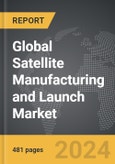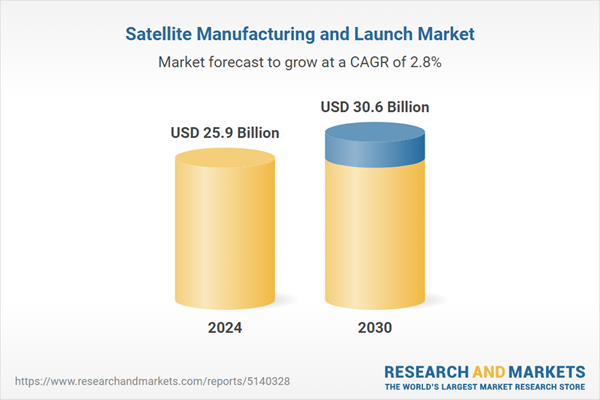Global Satellite Manufacturing and Launch Market - Key Trends & Drivers Summarized
Satellite manufacturing and launch are integral components of the space industry, facilitating the deployment of satellites for a multitude of applications, including communication, navigation, Earth observation, and scientific research. The process of satellite manufacturing involves the design, assembly, and testing of complex systems that must withstand the harsh conditions of space. This includes the integration of advanced technologies such as high-resolution cameras, communication transponders, power systems, and propulsion units. Manufacturers must ensure that satellites are lightweight yet robust, using materials like carbon fiber composites and specialized alloys to balance durability and performance. Rigorous testing procedures, including thermal vacuum tests and vibration tests, are conducted to ensure the satellite's reliability and functionality in space.The launch phase of satellite deployment involves transporting the satellite into orbit using launch vehicles, commonly known as rockets. This phase is critical and requires precise coordination and timing to place the satellite into its designated orbit, whether it be low Earth orbit (LEO), medium Earth orbit (MEO), or geostationary orbit (GEO). Advances in rocket technology have led to the development of more efficient and cost-effective launch vehicles. Innovations such as reusable rockets, pioneered by companies like SpaceX with their Falcon 9, have significantly reduced the cost of access to space. Additionally, the emergence of small satellite launchers has provided more opportunities for launching small satellites and cubesats, which are increasingly used for scientific, commercial, and educational purposes. These advancements have democratized space access, enabling a broader range of organizations, including startups and educational institutions, to participate in satellite missions.
The growth in the satellite manufacturing and launch market is driven by several factors, including the increasing demand for satellite-based services, advancements in satellite and launch vehicle technologies, and supportive government policies. The proliferation of high-speed internet, global navigation systems, and Earth observation applications has spurred the need for more satellites. Technological advancements, such as the miniaturization of satellite components and the development of high-throughput satellites (HTS), have enhanced the capabilities and cost-effectiveness of satellite missions. Moreover, the advent of new space launch providers and the innovation of reusable launch systems have reduced launch costs, making space more accessible. Government initiatives and international collaborations aimed at expanding space capabilities and infrastructure further support market growth. These factors collectively contribute to a dynamic and rapidly evolving market, underscoring the critical role of satellite manufacturing and launch in the expanding space economy.
Report Scope
The report analyzes the Satellite Manufacturing and Launch market, presented in terms of market value (USD). The analysis covers the key segments and geographic regions outlined below.- Segments: Type (Satellite Manufacturing, Launch Systems); Application (Communication Satellites, Military Surveillance Satellites, Navigation Satellites, Earth Observation Satellites, Other Applications).
- Geographic Regions/Countries: World; United States; Canada; Japan; China; Europe (France; Germany; Italy; United Kingdom; and Rest of Europe); Asia-Pacific; Rest of World.
Key Insights:
- Market Growth: Understand the significant growth trajectory of the Communication Satellites Application segment, which is expected to reach US$11.2 Billion by 2030 with a CAGR of 3.4%. The Military Surveillance Satellites Application segment is also set to grow at 2.5% CAGR over the analysis period.
- Regional Analysis: Gain insights into the U.S. market, valued at $14.8 Billion in 2024, and China, forecasted to grow at an impressive 3% CAGR to reach $2.5 Billion by 2030. Discover growth trends in other key regions, including Japan, Canada, Germany, and the Asia-Pacific.
Why You Should Buy This Report:
- Detailed Market Analysis: Access a thorough analysis of the Global Satellite Manufacturing and Launch Market, covering all major geographic regions and market segments.
- Competitive Insights: Get an overview of the competitive landscape, including the market presence of major players across different geographies.
- Future Trends and Drivers: Understand the key trends and drivers shaping the future of the Global Satellite Manufacturing and Launch Market.
- Actionable Insights: Benefit from actionable insights that can help you identify new revenue opportunities and make strategic business decisions.
Key Questions Answered:
- How is the Global Satellite Manufacturing and Launch Market expected to evolve by 2030?
- What are the main drivers and restraints affecting the market?
- Which market segments will grow the most over the forecast period?
- How will market shares for different regions and segments change by 2030?
- Who are the leading players in the market, and what are their prospects?
Report Features:
- Comprehensive Market Data: Independent analysis of annual sales and market forecasts in US$ Million from 2024 to 2030.
- In-Depth Regional Analysis: Detailed insights into key markets, including the U.S., China, Japan, Canada, Europe, Asia-Pacific, Latin America, Middle East, and Africa.
- Company Profiles: Coverage of players such as Airbus SE, ArianeGroup SAS, Blue Origin, LLC, GeoOptics, Inc., Honeywell International, Inc. and more.
- Complimentary Updates: Receive free report updates for one year to keep you informed of the latest market developments.
Some of the 119 companies featured in this Satellite Manufacturing and Launch market report include:
- Airbus SE
- ArianeGroup SAS
- Blue Origin, LLC
- GeoOptics, Inc.
- Honeywell International, Inc.
- Innovative Solutions In Space B.V.
- Lockheed Martin Corporation
- Maxar Technologies, Inc.
- MITSUBISHI HEAVY INDUSTRIES LTD.
- Northrop Grumman Systems Corporation
- OHB SE
- Raytheon Technologies Corp.
- Sierra Nevada Corporation
- Space Exploration Technologies Corp.
- Thales Group
- The Boeing Company
- ViaSat, Inc.
This edition integrates the latest global trade and economic shifts into comprehensive market analysis. Key updates include:
- Tariff and Trade Impact: Insights into global tariff negotiations across 180+ countries, with analysis of supply chain turbulence, sourcing disruptions, and geographic realignment. Special focus on 2025 as a pivotal year for trade tensions, including updated perspectives on the Trump-era tariffs.
- Adjusted Forecasts and Analytics: Revised global and regional market forecasts through 2030, incorporating tariff effects, economic uncertainty, and structural changes in globalization. Includes historical analysis from 2015 to 2023.
- Strategic Market Dynamics: Evaluation of revised market prospects, regional outlooks, and key economic indicators such as population and urbanization trends.
- Innovation & Technology Trends: Latest developments in product and process innovation, emerging technologies, and key industry drivers shaping the competitive landscape.
- Competitive Intelligence: Updated global market share estimates for 2025, competitive positioning of major players (Strong/Active/Niche/Trivial), and refined focus on leading global brands and core players.
- Expert Insight & Commentary: Strategic analysis from economists, trade experts, and domain specialists to contextualize market shifts and identify emerging opportunities.
Table of Contents
Companies Mentioned (Partial List)
A selection of companies mentioned in this report includes, but is not limited to:
- Airbus SE
- ArianeGroup SAS
- Blue Origin, LLC
- GeoOptics, Inc.
- Honeywell International, Inc.
- Innovative Solutions In Space B.V.
- Lockheed Martin Corporation
- Maxar Technologies, Inc.
- MITSUBISHI HEAVY INDUSTRIES LTD.
- Northrop Grumman Systems Corporation
- OHB SE
- Raytheon Technologies Corp.
- Sierra Nevada Corporation
- Space Exploration Technologies Corp.
- Thales Group
- The Boeing Company
- ViaSat, Inc.
Table Information
| Report Attribute | Details |
|---|---|
| No. of Pages | 481 |
| Published | October 2025 |
| Forecast Period | 2024 - 2030 |
| Estimated Market Value ( USD | $ 25.9 Billion |
| Forecasted Market Value ( USD | $ 30.6 Billion |
| Compound Annual Growth Rate | 2.8% |
| Regions Covered | Global |









